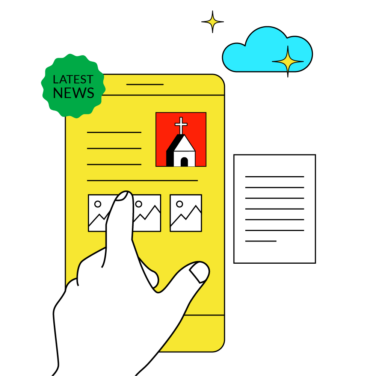Church technology can be a game changer—or a source of constant headaches. In this ultimate guide to church technology, I want to help you make sense of what tools are actually worth your time and investment.
When you don’t have the right tech setup:
- You waste hours trying to fix recurring problems (like livestream glitches or scheduling miscommunications).
- Your team gets frustrated with clunky tools that don’t talk to each other.
- You miss opportunities to reach and serve your congregation effectively.
These issues usually crop up because we’re either using outdated tools, or we’ve pieced together too many systems that don’t really work together.
That’s why I’ve pulled together this comprehensive list. It covers the best options across key areas—from communication and presentation, to giving and data management—so you can find the church technology solutions that actually work for your ministry.
Why Church Tech Matters Now More Than Ever
Modern church technology encompasses a broad range of software and hardware used to support ministry. It's an umbrella term that includes tools like
- church management software
- online giving platforms
- livestreaming equipment
- presentation and audio/visual systems
- mobile apps
- AI-based tools
While the church historically has been slow to embrace new technological advancements, that's not the case nearly as much today. According to Globe News Wire:
- 95% of U.S. churches say technology is critical to helping achieve their mission
- 90% of churches now offer a hybrid model (both in-person and online services)
- 91% are livestreaming worship each week
The Biblical Case for Innovation
Biblically, technology has always served ministry. The Apostle Paul used the Roman road system and handwritten letters—the tech of his time—to spread the Gospel. Later, the printing press fueled the Reformation. In modern times, radio and television carried the message worldwide.
While the message of The Gospel must never change, the methods can evolve. Jesus's command to “Go into all the world” today includes the digital world.
It's not just for big churches either:
This remarkable shift means even the smallest congregations are working to stay connected with homebound members, military families, or people traveling. It’s a sign of a greater cultural shift: younger generations expect on-demand digital engagement.
Church technology, when used well, can easily level the playing field. In 2025, small congregations have more access to tech than ever before.
Lilly endowment's "Connect Through Tech" Grant Program:
Today, even churches with 50 people can benefit from tech that was once reserved for megachurches. Scalable pricing, free tiers, and grant initiatives have leveled the playing field. In 2020-2021, over 2,700 congregations received grants to implement online ministry tools through the Lilly Endowment’s church grant “Connect Through Tech” program.
This and other church grants ARE available, for churches who successfully apply.
Common Types of Church Technology (with Use Cases)
Church and technology used to feel like oil and water. Not anymore. These days, tech isn’t just helpful—it’s essential to how we gather, communicate, and care for people. Here’s a breakdown of the kinds of church technology that actually help, plus how pastors are using them in real life.
1. Church Management Software (ChMS)
Think of your church management software tool this as your church’s nerve center. It tracks people, events, giving, attendance, groups—you name it. Tools like Planning Center, Breeze, and Realm let you stay organized without getting buried in spreadsheets.
New Covenant Church (PA) implemented a new ChMS and went from scrambling on Sunday mornings to calmly managing volunteers, sending follow-up emails, and spotting when folks stopped showing up. That’s not just good admin—that’s good leadership.
2. Online Giving Tools
The best online giving tools like Tithe.ly, Pushpay, and Subsplash have made giving easy—web, text, app, whatever. When people can give on their phones, giving goes up. Most churches see a 10–15% bump just by removing the awkward hurdles.
St. John's Lutheran church trained their folks how to use Tithe.ly's online giving tools and saw giving jump 15%, driven especially by donations from their younger members.
3. Livestream & Media Tech
Livestreaming is the new front door. Most first-time guests are watching from their couch before they ever walk in your building. You don’t need a full production team. At the bare minimum, a smartphone and free software can get your service online.
On the other end of the spectrum, explore ProPresenter or other church presentation software tools to run your lyrics and slides, while OBS helps stream to Facebook or YouTube.
4. Volunteer Scheduling Tools
You’ve got people who want to serve. You just need to organize ‘em. Planning Center Services and Ministry Scheduler Pro allow folks see their schedules, swap dates, and block out vacation. That means no more Saturday night panics or passive-aggressive group texts. A healthy schedule honors people’s time and prevents burnout.
Using volunteer scheduling tools will result in increasing volunteer participation and a drop in admin hours. Clear schedules, easy swaps, and built-in reminders created a more organized and respectful volunteer experience.
5. Communication Tools
Churches that lean into direct church communication see better turnout and fewer “I didn’t know about that” moments. The best church communication tools offer an impressive suite of tools:
Email newsletters. Text reminders. Push notifications. Mailchimp. Text In Church. Church app notifications. Use whatever channels your people actually read. A last-minute service change via text reaches more folks than a Sunday announcement ever will.
6. AI & Automation for Admin
From sermon transcription to automatic visitor follow-ups, AI is starting to save pastors serious time. Tools like ChatGPT can help sharpen and elevate sermon outlines or create first drafts for newsletters. Workflow automation (e.g. connecting website forms to email systems) also ensures no one falls through the cracks, even in a busy season.
Together, these tools aren’t just about efficiency—they’re about strengthening relationships, reducing ministry stress, and increasing your church’s impact. Choose the tools that align with your church’s needs and use them as a foundation to care for people more effectively.
Small Church, Big Impact: New Covenant Church (PA)
New Covenant Church in Berwick, PA (about 350 in attendance), was relying on patchwork systems—PayPal for giving, manual website updates, and basic communications. In 2023, they upgraded to an integrated solution with Tithe.ly, including a church app, website builder, and digital giving. The result?
A more engaged congregation, better communication response rates, and a tech assistant who said, “I’m not a technical person, but I was able to do it.”
Excellent Church Management Software
| Tool | Best For | Trial Info | Price | ||
|---|---|---|---|---|---|
| 1 | Best for managing church donations and events | Free plan available | From $19/month (billed annually) | Website | |
| 2 | Best for all-in-one church management | Free plan available | From $12/month | Website | |
| 3 | Best for organizing member information | Free plan available | From $69.99/month | Website |
The Right Church Tech Resources & Tools for Your Church
Not every tech solution fits every church. The church software that works for a megachurch might be overkill for a mid-sized congregation—and what fits your neighbor’s church may not serve your mission.
The key is to choose tools that solve real problems, fit your team’s capacity, and serve your people well.
Factors to Consider (Budget, Team, Congregation)
- Start with the pain points you’re facing: Do you struggle to follow up with guests? Does scheduling volunteers eat up too much time? Are your livestreams unreliable? Choose tools that solve these issues first.
- Next, assess your budget and team capacity. Many tools offer free tiers or discounts for churches under a certain size. More complex systems may save time in the long run—but only if you have the volunteers or staff to run them. Simpler is often better.
- Lastly, know your congregation’s tech comfort level. A young church may thrive with app-based communication, while a congregation that skews older might need printed instructions and hands-on help.
Red Flags to Watch For
Not all church tech is created equal. Be cautious if a product:
- Locks you into a long-term contract without a trial period.
- Lacks customer support or clear documentation.
- Seems overly complex for your actual needs.
- Focuses more on “flash” than ministry function
Also beware of tools that silo your data or don’t integrate with others you’re already using. Disconnected systems often cause more problems than they solve.
Questions to Ask Church Tech Vendors Before Buying
Before committing, ask:
- What training and onboarding support do you offer?
- Can we test this with our team before buying?
- How well does this integrate with our current systems?
- Are there hidden fees (like per-user costs or add-ons)?
- What kind of support do you provide—chat, phone, email?
- What happens to our data if we leave your platform?
Good vendors should be transparent, ministry-minded, and eager to help—not just make a sale.
Choosing church technology isn’t about having the newest gadgets. It’s about choosing tools that align with your mission, fit your team’s abilities, and serve your people well. Start small, ask the right questions, and prioritize tools that make ministry easier, not harder.
Using Tech to Increase Accessibility: Westside Community Church (IN)
Westside Community Church embraced a hybrid model early. Post-COVID, they improved livestream quality, launched weekly sermon discussions in a Facebook Group, and integrated online prayer requests into Sunday services. One family drove two hours to visit after weeks of watching online. Online participants didn’t just watch—they joined. This inclusive approach boosted giving, volunteering, and long-term engagement.
Westside Community succeeded, not by chasing the latest gadgets—but because they chose tech that served their people, trained their teams well, and stayed focused on mission.
Tech Adoption Tips for Busy Pastors
Adopting new technology can feel like one more thing on a never-ending to-do list. But with a few intentional moves, pastors can lead their churches into better tools (for the sake of the benefits church tech offers)—without burnout or confusion.
1. Get Buy-In from Your Staff and Elders
Present the why before the what. Show how the tool supports ministry goals—like reaching more people, improving follow-up, or easing admin stress. Address concerns openly, especially around cost or complexity. When leadership is united, the rest of the church follows more easily.
2. Train Volunteers Without Overwhelming Them
Start with a few tech-savvy people, often younger members, and give them simple, hands-on training. Create “tech teams” where more experienced users can support others. Focus on what people need to know to serve well—don’t overteach. Celebrate early wins to build confidence.
3. Keep Your Church Culture Intact
Technology should feel like a support, not a shift in identity. Regularly remind your team and congregation that the goal is better ministry, not “more screens.” Create boundaries around usage (e.g. phones off during prayer) and highlight how tech is helping—not replacing—relationships.
Pastors don’t need to become tech experts. You just need to lead with clarity, stay rooted in your church’s mission, and invite your team to grow together as you adopt new tools.
The Future of Church Tech: Trends to Watch in 2025 and Beyond
Church technology is evolving fast—but not just in complexity. The three most important trends for 2025 are about making ministry simpler, more personal, and more accessible:
- The Rise of AI-Powered Ministry Tools... AI is becoming a real partner in ministry. Tools like ChatGPT are helping pastors draft sermons, create follow-up emails, and even summarize prayer requests. This doesn’t replace spiritual work—it removes admin noise so leaders can focus more on people.
- Tech for Hybrid Church Models... Post-pandemic, many churches now operate in a “hybrid” format. The in-person Sunday gathering is still central—but midweek discipleship, prayer, and outreach often happen online. Platforms that integrate livestreams, mobile apps, and group messaging support both physical and digital fellowship.
- Ethics and Discernment in Adopting New Tech... As tools become more powerful, the need for pastoral discernment grows. The best churches treat tech as a tool, not a crutch—anchoring every decision in Scripture, not novelty. Pastors must lead by example, showing that love and presence always come before automation.







